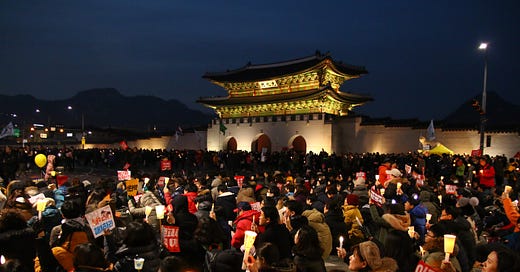21st Century Self Defense in the Asia Pacific
Why Japan and South Korea might be looking at the nuclear option.
Historical Context
In the 1940s and 1950s, Japan and South Korea were devastated by the Second World War and the Korean Civil War respectively. In the post-war era, both countries allied themselves with the United States, as a defense against threats from the Soviet Union and North Korea. Through its influence, the United States was able to effectively establish strong security guarantees with both Japan and South Korea, attaining significant physical troop presence in Asia.
Japan’s post-war Constitution was written primarily by Americans and focused on peace in the wake of its crimes duringWorld War II. In the new constitution, Japan gave up its military, eliminating war as a means of settling international disputes. For Korea, political institutions were modelled largely after the United States and the country received copious amounts of American economic aid.
Despite both countries’ assurances of protection from the United States, South Korea took a aggressive approach to developing its military due to the North Korean threat, while Japan largely remained demilitarized due to its constitutional obligations.
Geopolitical Change
However, there have been developments in the intervening decades. While Soviet interests are now different (as Russia), China has become a major world power and North Korea has leveled up its military. With the sour history between the Asian powers, Japan and Korea are wary ofChina’s ascent to power.
China today is an economic powerhouse and has a highly advanced military, which dwarfs Korea and Japan. These shifts in regional power dynamics have spurred significant policy discussions in Tokyo and Seoul, particularly in light of recent provocations by North Korea and evolving U.S. foreign policy.
In light of this, Japan and South Korea have proposed significant remilitarization and closer ties to the United States.
According to New York Times writer Choe Sang-Hun, South Korea has long considered pursuing a nuclear program a taboo, as it is contrary to Washington’s wishes. However, there is a growing desire in South Korea for self-reliance, especially in the face of Donald Trump’s inward focus on the United States.
Similarly, Japanese Prime Minister Shigeru Ishiba in October 2024 called for the creation of an ‘Asian NATO’ and said that the U.S. should rethink its nuclear strategy in opposition tothe Russia-China-North Korea axis that has formed in East Asia.
Both Japan and Korea possess the economic capabilities, human capital, and physical resources to develop nuclear weapons, according to the PIR Center and War on the Rocks.
These security concerns are inherently related to the re-election of President Donald Trump and his ‘America First’ agenda. President Trump’s election promises included a reduction in foreign aid and promised disengagement and withdrawal from world politics. This isolationist stance worries American allies in close proximity to China.
The Georgetown Review reached out to John Severini, a PhD student at Georgetown University with a background in military research, on the feasibility of Japanese and Korean nuclear weapons.
Severini is of the opinion that a “major international shake-up” would be required for Japan and South Korea to reform their perspective on nuclear norms, and develop nuclear programs. He said that while some conditions already exist for this, the countries do not yet possess a concrete reason to pursue such a policy change.
Severini also added that shifts in the American policy scene and security policy could lead to nuclear mobilization in East Asia.
Recent Developments
On January 13, 2025, Japan and South Korea’s foreign ministers held a meeting to discuss developing security challenges. The meeting was reportedly in response to North Korea’s recent missile tests and closer alliance with Russia, and China’s maritime claims in the South and East China seas. Just a week prior to the meeting, North Korea had conducted missile tests while US Secretary of State Antony Blinken was visiting Seoul.
With the recent political upheaval in South Korea, the government change in Japan, and the inauguration of Donald Trump, a new era of uncertainty looms over East Asia.
Public sentiment in both nations highlights contrasting attitudes toward nuclear development. In Japan, strong anti-nuclear sentiment persists, with approximately 75% of citizens supporting disarmament treaties like the Treaty on the Prohibition of Nuclear Weapons (TPNW). Conversely, South Korean public opinion show increasing support for indigenous nuclear development, with recent polls indicating that over 70% favor acquiring nuclear weapons. If either country were to pursue nuclear armament, it could trigger a regional arms race involving China and North Korea while undermining global non-proliferation norms. Such a move would also risk alienating their key ally, the United States, and invite significant economic and diplomatic repercussions.
Additionally, U.S. President Donald Trump’s recent remarks referring to North Korea as a "nuclear power" have sparked concerns in both Tokyo and Seoul. While South Korea has rejected any recognition of North Korea as a legitimate nuclear state under the Nuclear Non-Proliferation Treaty (NPT), Trump’s comments suggest a potential shift in U.S. policy that could undermine long-standing denuclearization efforts. This has raised alarms about the reliability of U.S. commitments to regional security.
In response to these challenges, Japan and the United States announced new guidelines on December 26, 2024, to strengthen nuclear deterrence. These guidelines reportedly include provisions for closer communication between Japan’s Self-Defense Forces and U.S. military leadership regarding the use of nuclear force. This marks a significant step toward integrating Japan into U.S. strategic planning, reflecting Tokyo’s growing concerns about its security environment.
South Korea and Japan remain cautious about constant developments in East Asia as they seek to ensure self-defense without alienating their closest ally, the United States. The question remains whether these nations will continue relying on U.S.-backed security guarantees or take more drastic steps toward self-reliance amidst an increasingly volatile geopolitical landscape. Their decision could be critical in triggering or preventing an arms race in East Asia and causing immense diplomatic fallout.






